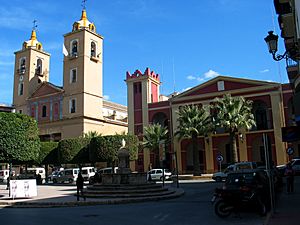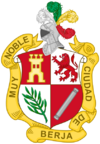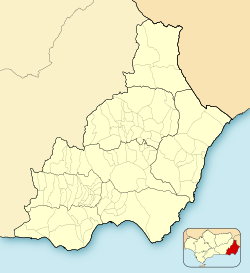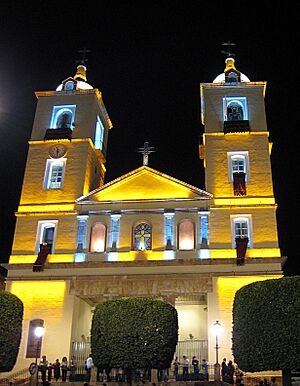Berja facts for kids
Quick facts for kids
Berja
|
|||
|---|---|---|---|
 |
|||
|
|||
| Country | |||
| Community | |||
| Province | |||
| Comarca | Poniente Almeriense | ||
| Area | |||
| • Total | 218 km2 (84 sq mi) | ||
| Elevation | 335 m (1,099 ft) | ||
| Population
(2018)
|
|||
| • Total | 12,381 | ||
| • Density | 56.79/km2 (147.1/sq mi) | ||
| Time zone | UTC+1 (CET) | ||
| • Summer (DST) | UTC+2 (CEST) | ||
Berja is a town and municipality (a type of local government area) in the Almería province of southern Spain. It is part of the Andalusia region. Berja is located on the south-eastern side of the Sierra de Gádor mountains. It is about 16 kilometers (10 miles) north-east of Adra.
History of Berja
Berja has a very long history. It might have been founded by the Phoenicians or Iberians long ago. The Romans knew it as Vergis or Vergium. It was part of a Roman province called Baetica. You can still see Roman remains in an area called Villa Vieja. These include parts of an amphitheater (a place for shows) and an aqueduct (a water channel). There are also mosaics (pictures made from small colored pieces) similar to those found in the ancient Roman cities of Pompeii and Herculaneum.
It is believed that Saint Ctesiphon, the town's patron saint, brought Christianity to the area in the first century. Coins, crosses, and a sarcophagus (a stone coffin) from this time have been found. A copy of the sarcophagus is in the Museum of Almería.
In the fifth century, an earthquake damaged the Roman town. After this, the Roman town broke into smaller communities. Berja became the most important of these. When the Moors arrived in Spain in the eighth century, the town was called Berja. They built a fortress there. You can still see parts of Moorish baths in the Benejí area.
Christian forces took control of Berja in 1489 during the Reconquista (the Christian reconquest of Spain). A big uprising by the Moriscos (Moors who had converted to Christianity) in 1568 caused many deaths in Berja. The town was almost empty after this event. In 1588, two hermits founded a special place dedicated to the Virgen de Gádor, who became a patroness of Berja.
Berja was managed by the town of Ugíjar until 1753. Then, it was allowed to have its own mayor. In 1804, another earthquake destroyed much of the town.
In 1833, Spain's old administrative system was changed into provinces. Berja became part of the province of Almería. In the 19th century, people started mining lead in Berja. This made the city grow and become very successful.
More recently, a community called Balanegra used to be part of Berja. But in 2015, Balanegra became its own separate municipality. This change meant Berja no longer had a coastline.
Berja's Religious Past
Saint Ctesiphon is said to have brought Christianity to Berja when it was a Roman town. Around the year 500, Berja became a bishopric, which means it had its own bishop. However, this ended around 711 when the Moors conquered the area.
Later, in 1969, the old bishopric of Berja was given a special title called a "titular see." This means it's a historical bishopric that no longer has a resident bishop, but the title can be given to other bishops for honorary reasons.
Economy
Berja was once famous for its lead mines. These mines were very important for the city's growth in the 19th century.
From the 16th century, Berja also started making wine. This wine became popular in the 19th century under the name Salobra.
Today, Berja is also home to a solar plant. This plant uses the sun's energy to create electricity. It opened in 2007 on top of Montivel mountain.
Climate
Berja has a very sunny, warm, and dry climate. It is located in a semi-arid climate zone, which means it gets very little rain. This makes it one of the driest places in Mediterranean Europe.
See also
 In Spanish: Berja para niños
In Spanish: Berja para niños







